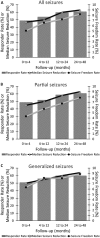Rates and Predictors of Seizure Freedom With Vagus Nerve Stimulation for Intractable Epilepsy
- PMID: 26645965
- PMCID: PMC4884552
- DOI: 10.1227/NEU.0000000000001165
Rates and Predictors of Seizure Freedom With Vagus Nerve Stimulation for Intractable Epilepsy
Abstract
Background: Neuromodulation-based treatments have become increasingly important in epilepsy treatment. Most patients with epilepsy treated with neuromodulation do not achieve complete seizure freedom, and, therefore, previous studies of vagus nerve stimulation (VNS) therapy have focused instead on reduction of seizure frequency as a measure of treatment response.
Objective: To elucidate rates and predictors of seizure freedom with VNS.
Methods: We examined 5554 patients from the VNS therapy Patient Outcome Registry, and also performed a systematic review of the literature including 2869 patients across 78 studies.
Results: Registry data revealed a progressive increase over time in seizure freedom after VNS therapy. Overall, 49% of patients responded to VNS therapy 0 to 4 months after implantation (≥50% reduction seizure frequency), with 5.1% of patients becoming seizure-free, while 63% of patients were responders at 24 to 48 months, with 8.2% achieving seizure freedom. On multivariate analysis, seizure freedom was predicted by age of epilepsy onset >12 years (odds ratio [OR], 1.89; 95% confidence interval [CI], 1.38-2.58), and predominantly generalized seizure type (OR, 1.36; 95% CI, 1.01-1.82), while overall response to VNS was predicted by nonlesional epilepsy (OR, 1.38; 95% CI, 1.06-1.81). Systematic literature review results were consistent with the registry analysis: At 0 to 4 months, 40.0% of patients had responded to VNS, with 2.6% becoming seizure-free, while at last follow-up, 60.1% of individuals were responders, with 8.0% achieving seizure freedom.
Conclusion: Response and seizure freedom rates increase over time with VNS therapy, although complete seizure freedom is achieved in a small percentage of patients.
Abbreviations: AED, antiepileptic drugVNS, vagus nerve stimulation.
Figures



Comment in
-
Commentary: Rates and Predictors of Seizure Freedom With Vagus Nerve Stimulation for Intractable Epilepsy.Neurosurgery. 2016 Sep;79(3):354-5. doi: 10.1227/NEU.0000000000001215. Neurosurgery. 2016. PMID: 26901145 No abstract available.
References
-
- Spencer S, Huh L. Outcomes of epilepsy surgery in adults and children. Lancet Neurol. 2008;7(6):525-537. - PubMed
-
- Englot DJ, Lee AT, Tsai C, et al. Seizure types and frequency in patients who “fail” temporal lobectomy for intractable epilepsy. Neurosurgery. 2013;73(5):838-844. - PubMed
-
- Engel J, Jr, Wiebe S. Who is a surgical candidate? Handb Clin Neurol. 2012;108:821-828. - PubMed
Publication types
MeSH terms
Grants and funding
LinkOut - more resources
Full Text Sources

